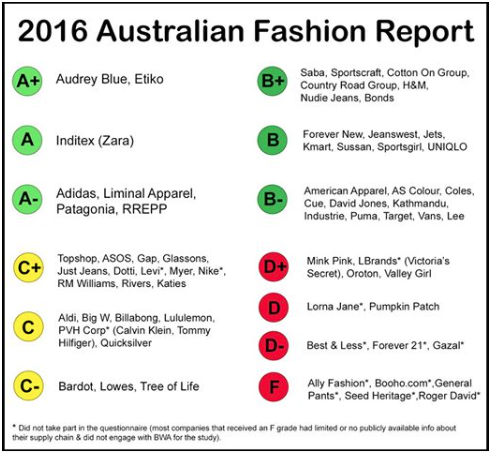When I asked my friends on Facebook if anyone had bought something really cheap, despite knowing it had probably been made in dodgy factories, the main reason given was not having much money to spend. That made me more optimistic, because ethical fashion isn’t necessarily expensive.
It came as a huge surprise to me to discover that brands making efforts to source garments ethically include many that produce cheap clothing. Brands like Target, Kmart, Uniqlo and Zara have a good score on the 2016 Australian Fashion Report compiled by Baptist World Aid.

So how do these companies sell clothing cheap while still addressing ethical and environmental issues?
The first and most obvious answer is larger scales of production. Large orders require less staff training per garment, mean less time wasted between jobs, etc. Because of these economies of scale, when you produce garments in the millions it might only cost 10 cents per garment more to improve the social and environmental impact of that garment.
The next answer isn’t surprising: cheap means cheap. Cost cuts result in lower quality materials and sewing, and there has to be a consequence: and that is that the $5 t-shirt or $20 pair of jeans isn’t going to last long. Or even the $10 t-shirt and $40 pair of jeans.
I wouldn’t be surprised if workers being able to afford to eat enough calories to work their punishing 100 or so hour a week shifts, helps prevent construction errors, too.
But the most interesting reason that ethical brands can compete at the low end is that by taking control of supply lines, cutting out the middlemen and treating workers well may actually save them money.
A large part of the reason bad labour conditions for workers came about is that when, a decade or two ago, brands shifted garment manufacturing overseas factories they stopped taking responsibility for supply lines. They left it to subcontractors to employ factories or home-based workers, and those subcontractors were – and many still are – unscrupulous in lowering prices as far as possible so they get a better cut. The factory workers at the end of the line end up with what’s left over. The more subcontractors the less money the workers get. It’s also system that makes it hard for brands to control the conditions workers are enduring.
After Rana Plaza, the huge factory fire and building collapse in Bangladesh a few years back in which over a thousand garment workers died, the Bangladesh Accord was devised (http://bangladeshaccord.org/about/) and brands began to implement codes of practice. The factories they use are independently audited regularly to ensure they are sticking to a basic set of principles of safety and fair labour conditions, and deal with issues of environmental degradation and pollution. Of course, attempts are made to get around the restrictions. Some big brands have trusted subcontractors to choose factories with fair working practises only to find those factories secretly subcontracted to ones that don’t. As a result, they’re beginning to set up their own supply lines and factories.
But the main point of this post is: you don’t have to buy expensive clothing to make a difference, just be a bit more selective in your shopping. Brands with an ethical/sustainable fashion policy include it on their website. Independent organisations like http://www.baptistworldaid.org.au/assets/Be-Fair-Section/FashionReport.pdf and http://ethicalclothingaustralia.org.au, have lists of stores.
Also, be extra careful of online shopping. By bypassing local retailers completely you may be not only shopping direct from the countries with the worst social and environmental problems, but undermining efforts to improve them.
